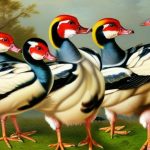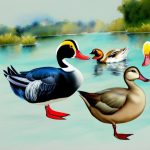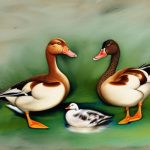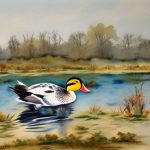Muscovy ducks, scientifically known as Cairina moschata, are large, heavy-bodied ducks native to Mexico, Central, and South America. They are a popular domesticated breed and are often found in ponds, lakes, and rivers across the United States. Muscovy ducks are easily recognizable by their unique appearance, with a distinctive red facial caruncle, which is a fleshy growth on the face, and a prominent knob at the base of the bill. They come in a variety of colors, including black, white, chocolate, and blue, and are known for their quiet and docile nature.
Muscovy ducks are highly adaptable and can thrive in a variety of environments, from urban parks to rural farms. They are excellent foragers and will eat a wide range of foods, including insects, plants, and small fish. Muscovy ducks are also known for their strong flying abilities and can often be seen perching in trees or on rooftops. They are highly social birds and are often found in small flocks, where they engage in various social behaviors such as preening, bathing, and foraging together. Overall, Muscovy ducks are fascinating creatures with unique characteristics that make them a popular choice for bird enthusiasts and farmers alike.
Table of Contents
Key Takeaways
- Muscovy ducks are a unique breed known for their quiet nature and distinctive appearance, with males being larger and having more prominent caruncles than females.
- Courtship and pair bonding in Muscovy ducks involve elaborate displays and vocalizations, with pairs forming strong bonds that can last for years.
- Nesting and egg laying typically occur in secluded areas near water, with females laying a clutch of 8-16 eggs and then incubating them for about 35 days.
- Incubation and brooding duties are primarily carried out by the female, who fiercely defends her nest and young from potential threats.
- Duckling care and rearing involves the female leading her brood to water shortly after hatching, where they learn to forage and navigate their environment under her watchful eye.
Courtship and Pair Bonding
Muscovy ducks are monogamous birds, forming strong pair bonds that can last for several breeding seasons. During the courtship period, male Muscovy ducks will engage in elaborate displays to attract a mate. This can include head bobbing, wing flapping, and vocalizations to impress the female. Once a pair bond is formed, the male will become highly protective of the female, often staying close to her side and defending her from potential threats.
Pair bonding in Muscovy ducks is an important aspect of their reproductive behavior, as it ensures the success of their offspring. The bond between the male and female is crucial for successful nesting and raising of ducklings. Once a pair bond is established, the male will often accompany the female as she searches for a suitable nesting site and will actively participate in nest building. Overall, courtship and pair bonding in Muscovy ducks are fascinating behaviors that highlight the strong social bonds and cooperative nature of these birds.
Nesting and Egg Laying
Nesting is a crucial part of the reproductive cycle for Muscovy ducks. The female will search for a suitable nesting site, often choosing a secluded area near water with plenty of vegetation for cover. Muscovy ducks are known for their preference for nesting in tree cavities or elevated areas such as rooftops or barns. Once a suitable site is found, the female will begin to construct a nest using materials such as grass, leaves, and feathers.
After the nest is built, the female will begin to lay eggs, typically laying one egg per day until she has a clutch of 8-15 eggs. Muscovy duck eggs are large and creamy white in color, with an average incubation period of 35 days. During the egg-laying process, the female will spend a significant amount of time on the nest, only leaving briefly to feed and bathe. The male will often stand guard nearby, keeping watch for potential predators while the female tends to her eggs. Overall, nesting and egg laying are critical stages in the reproductive cycle of Muscovy ducks and play a vital role in the successful hatching of ducklings.
Incubation and Brooding
After the female has finished laying her clutch of eggs, she will begin the incubation process. Muscovy ducks are known for their strong maternal instincts, and the female will diligently incubate her eggs, rarely leaving the nest except for brief periods to feed and drink. During this time, the male will continue to stand guard nearby, providing protection for the nesting female and her eggs.
The incubation period for Muscovy duck eggs is approximately 35 days, during which time the female will carefully regulate the temperature and humidity of the nest to ensure the development of the embryos. Once the eggs begin to hatch, the female will assist the ducklings in breaking free from their shells and will then lead them to water shortly after hatching. The brooding period is crucial for the survival of the ducklings, as they rely on the warmth and protection of the mother to thrive during their early days. Overall, incubation and brooding are essential stages in the reproductive cycle of Muscovy ducks and highlight the dedication and care that these birds exhibit towards their offspring.
Duckling Care and Rearing
Once the ducklings have hatched, the female Muscovy duck will lead them to water where they can begin to forage for food. Ducklings are precocial birds, meaning they are born with their eyes open and are able to feed themselves shortly after hatching. The mother will continue to provide protection and guidance for her ducklings as they learn to navigate their environment and develop their foraging skills.
Muscovy duck mothers are highly attentive to their offspring, keeping a close watch over them as they explore their surroundings. The mother will also teach her ducklings important behaviors such as preening, bathing, and social interactions with other ducks. The male may also play a role in caring for the ducklings, providing protection and guidance as they grow. Overall, duckling care and rearing are critical stages in the reproductive cycle of Muscovy ducks and highlight the nurturing nature of these birds towards their young.

Muscovy ducks are highly social birds that engage in a variety of behaviors to communicate with one another. They use vocalizations such as quacks, hisses, and grunts to convey messages to other ducks in their flock. These vocalizations can serve as warnings of potential danger or as calls to gather together for foraging or resting.
In addition to vocalizations, Muscovy ducks also use body language to communicate with one another. This can include head bobbing, tail wagging, and wing flapping as a way to display dominance or submission within the flock. Social behavior is an important aspect of Muscovy duck life, as it helps them establish hierarchies within their groups and maintain cohesion among flock members. Overall, social behavior and communication play a crucial role in the daily lives of Muscovy ducks and contribute to their strong sense of community within their flocks.
Breeding Season and Reproductive Cycles
Muscovy ducks typically breed during the spring and summer months when food sources are abundant, and environmental conditions are favorable for nesting and raising offspring. Breeding season is marked by an increase in courtship displays among males as they compete for the attention of females. Once pair bonds are formed, nesting sites are selected, and females begin laying their eggs.
The reproductive cycle of Muscovy ducks is closely tied to environmental factors such as temperature and food availability. These factors can influence the timing of breeding seasons and the success of nesting attempts. Muscovy ducks may also exhibit seasonal variations in their reproductive behavior based on geographic location and local climate conditions. Overall, breeding season and reproductive cycles are important aspects of Muscovy duck life that contribute to the continuation of their species and highlight their adaptability to changing environmental conditions.
In conclusion, Muscovy ducks are fascinating birds with unique reproductive behaviors that highlight their strong pair bonds, nurturing parental care, and social interactions within their flocks. Their ability to adapt to a variety of environments and their cooperative nature make them a valuable species both in natural habitats and domestic settings. Understanding the reproductive cycle of Muscovy ducks provides valuable insight into their biology and behavior while also emphasizing the importance of conservation efforts to ensure the continued success of these remarkable birds in the wild.
If you’re interested in learning more about muscovy duck breeding behavior, you might also want to check out this insightful article on how big a coop needs to be for chickens. Understanding the space requirements for poultry can provide valuable insights into their natural behaviors and needs, which can be beneficial when considering muscovy duck breeding.
FAQs
What is the breeding behavior of Muscovy ducks?
Muscovy ducks are known for their unique breeding behavior, which includes courtship displays, mating rituals, and nest building.
How do Muscovy ducks court and mate?
Muscovy ducks engage in elaborate courtship displays, which may include head bobbing, wing flapping, and vocalizations. Once a pair has formed, they will mate, often in the water.
Where do Muscovy ducks build their nests?
Muscovy ducks prefer to build their nests in tree cavities, but they will also use nesting boxes or other sheltered areas. They line their nests with down feathers for insulation.
How many eggs do Muscovy ducks typically lay?
Muscovy ducks can lay anywhere from 8 to 16 eggs in a single clutch, with an average of around 12 eggs. The female will then incubate the eggs for about 35 days.
Do Muscovy ducks exhibit parental care?
Muscovy ducks are attentive parents and will fiercely protect their nests and young. Both the male and female may take turns incubating the eggs and caring for the ducklings.
Meet Walter, the feathered-friend fanatic of Florida! Nestled in the sunshine state, Walter struts through life with his feathered companions, clucking his way to happiness. With a coop that’s fancier than a five-star hotel, he’s the Don Juan of the chicken world. When he’s not teaching his hens to do the cha-cha, you’ll find him in a heated debate with his prized rooster, Sir Clucks-a-Lot. Walter’s poultry passion is no yolk; he’s the sunny-side-up guy you never knew you needed in your flock of friends!







